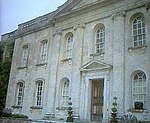St Catherine's Chapel, Abbotsbury
Chapels in EnglandChurches in DorsetEnglish Heritage sites in DorsetGrade I listed churches in Dorset

St Catherine's Chapel is a small chapel situated on a hill above the village of Abbotsbury in Dorset, England. It is dedicated to Saint Catherine. It is now in the guardianship of English Heritage, and became a Grade I listed building in 1956. The chapel is also scheduled together with the field systems and quarries on the hill.The chapel is best seen from the viewpoint on the B3157 Abbotsbury to Bridport road, with Chesil Beach in the background. The medieval strip lynchets etched into the side of the hill are known locally as the Chapel Rings.
Excerpt from the Wikipedia article St Catherine's Chapel, Abbotsbury (License: CC BY-SA 3.0, Authors, Images).St Catherine's Chapel, Abbotsbury
Seaway Lane,
Geographical coordinates (GPS) Address Phone number Website External links Nearby Places Show on map
Geographical coordinates (GPS)
| Latitude | Longitude |
|---|---|
| N 50.661519444444 ° | E -2.6064055555556 ° |
Address
St Catherine's Chapel
Seaway Lane
DT3 4JH , Abbotsbury
England, United Kingdom
Open on Google Maps










